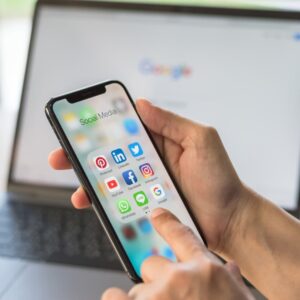There it is. The soul crushing notification. “Your LinkedIn account has been restricted.”
Welcome to LinkedIn jail, that uncomfortable purgatory where your perfectly legitimate professional profile is suddenly treated like you’re running some kind of digital pyramid scheme from your basement.
Don’t panic. At Harrison Sands, the vast majority of our team have been thrown in LinkedIn jail at some point in their careers, so we’re sharing firsthand experience on getting out quickly. We’ve seen this happen to everyone from rookie recruiters to C suite executives with blue ticks. The good news? It’s almost always fixable, and we’re about to show you exactly how to spring yourself from LinkedIn prison.
While we covered how to avoid restrictions in our previous blog, prevention isn’t always possible. This article focuses on what to do if you’re already facing a LinkedIn ban.
What actually happened to your account?
When LinkedIn restricts you, you’ll see that dreaded notification telling you your account has limited functionality. Translation: you’ve somehow triggered LinkedIn’s suspicion algorithm, typically without having any clue what you did wrong.
There’s a crucial difference between restriction and suspension. Think of a restriction as LinkedIn giving you a stern warning and temporary timeout. Usually reversible, and you might still have access to some features. This is like getting detention, not expelled.
A suspension is the serious one, potentially permanent digital exile. This typically happens after you’ve been restricted multiple times or did something that made LinkedIn’s algorithm clutch its pearls in horror. A LinkedIn ban at this level can be much harder to reverse.
“What did I do?!” The real reasons LinkedIn threw you in the penalty box
Let’s be brutally honest about why LinkedIn decided to put you in digital timeout. After seeing hundreds of these LinkedIn ban cases, here are the most common triggers we’ve encountered:
The identity red flags
Creating a profile for your business instead of yourself is a one-way ticket to restriction city. LinkedIn wants real people with real faces and real names, not thinly disguised companies trying to expand their reach.
Your profile photo matters enormously too. Those artsy, half-hidden faces or distant shots where you’re barely visible? They’re restriction magnets during verification processes.
For us at Harrison Sands, we’ve typically been restricted for having “rec2rec” in our names or profile photos that weren’t clearly visible. These might seem like minor issues, but they’re common triggers for a LinkedIn ban.
The activity red flags
LinkedIn closely monitors how you use the platform, and certain patterns immediately trip their alarm systems. Mass connection sprees, especially when they result in a low acceptance rate, virtually guarantee a restriction.
The platform also watches your acceptance rate closely. If you’re getting a lot of “I don’t know this person” responses, LinkedIn starts wondering if you’re just randomly connecting with people rather than building a genuine network.
Pending connection overload is another common trigger. Having hundreds of unanswered connection requests sitting in your account looks suspiciously like spam activity to LinkedIn’s monitoring systems, often resulting in a LinkedIn ban.
Breaking out of LinkedIn prison: Your freedom strategy
If you’re currently staring at a restricted account notification or facing a LinkedIn ban, here’s your jailbreak plan:
Verify your identity
Most restrictions require you to prove you’re a real human being and not three recruitment bots in a trench coat. Look for the verification prompts when you try to log in and be ready to upload official ID, both front and back images of your passport or driver’s licence.
Complete any verification steps without skipping anything. Half measures never work here. Then comes the hardest part: waiting. This typically takes 2-7 days, though sometimes it resolves faster.
If your first verification attempt is rejected, try again with clearer images, as poor photo quality is a common reason for rejection.
Get LinkedIn support’s attention (without sounding desperate)
If the standard verification process isn’t working, it’s time to contact LinkedIn directly. Use their Help Centre, but don’t just copy paste some template message. Navigate to “Account Access and Security” > “Account Access Issues” to find the right contact form.
Be specific about your situation; vague “my account is broken” complaints won’t get you anywhere. Screenshot the error message you’re receiving, as this helps support identify your issue faster. If you broke some rules, own it. LinkedIn respects honesty more than excuses when dealing with a LinkedIn ban.
Keep your message professional and concise. Follow up if you don’t get a response within five business days, but limit yourself to one polite follow up, not daily harassment.
Leverage your company’s LinkedIn relationship
If your company has a LinkedIn Account Manager, this is the time to get them involved. Corporate accounts often have direct channels to LinkedIn support that can expedite your case significantly.
Ask your marketing team, HR department, or whoever manages your company’s LinkedIn presence to reach out to your Account Manager on your behalf. They can often escalate LinkedIn ban cases through internal channels that regular users can’t access.
This approach is particularly effective for larger companies with established LinkedIn partnerships, as Account Managers have more influence over restriction decisions.
Call in the cavalry
Sometimes, social proof works wonders in getting your account back. Ask 3-5 colleagues (not 50, that looks suspicious) to report they can’t connect with you professionally. They should use LinkedIn’s Help Centre and specifically mention they’re trying to reach you for legitimate professional reasons.
Getting a few trusted connections to vouch for your account’s legitimacy can significantly speed up the review process, especially when dealing with a LinkedIn ban. If you work for a company with a LinkedIn corporate account, ask your admin to contact LinkedIn on your behalf.
We’ve seen this approach cut resolution time in half. There’s something about multiple people confirming you’re a real professional that makes support staff prioritise your case.
What about violations for inappropriate content?
While most restrictions are triggered by innocent technical missteps, LinkedIn also issues bans for content violations. At Harrison Sands, we need to be clear: if you’ve been hit with a LinkedIn ban for posting offensive content, trolling other users or engaging in harassment, our sympathy meter drops to zero.
This guide is specifically for professionals who’ve triggered algorithmic restrictions through everyday platform usage, not for those deliberately testing LinkedIn’s boundaries. The recruitment industry relies on trust, and even if you somehow regain access after a content violation, screenshots live forever.
Your next step
If you’re reading this with a restricted account or facing a LinkedIn ban, start the verification process immediately. Don’t wait, as delays can sometimes complicate matters.
Here’s a quick checklist for immediate action:
- Verify your identity through LinkedIn’s official channels
- Prepare clear, well lit copies of your identification
- Document any error messages for support tickets
- Check your email regularly for updates from LinkedIn
- Contact your company’s LinkedIn Account Manager if available
- Ask colleagues to help vouch for your legitimacy
- Stay patient and professional throughout the process
Remember, LinkedIn is just one tool in your professional arsenal. A temporary restriction or LinkedIn ban might feel catastrophic in the moment, but we’ve never seen it permanently damage anyone’s career.


